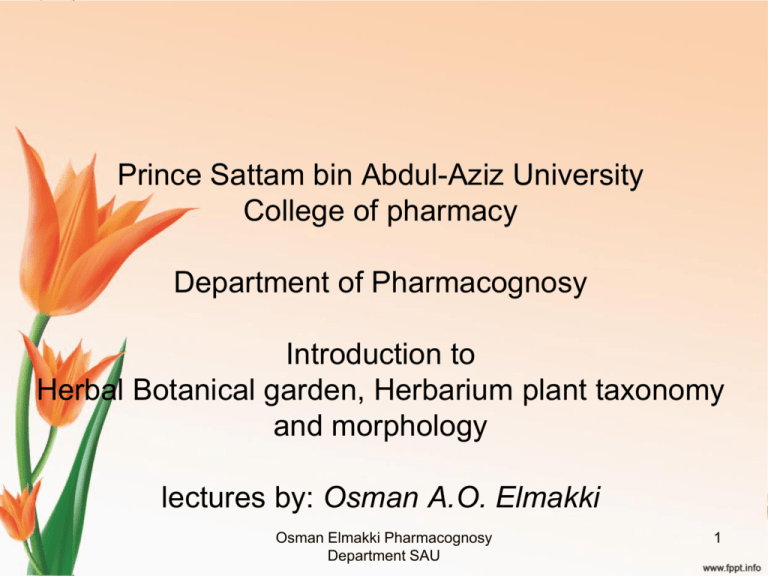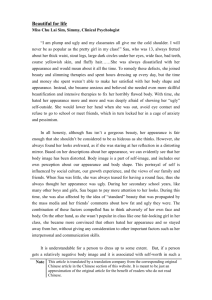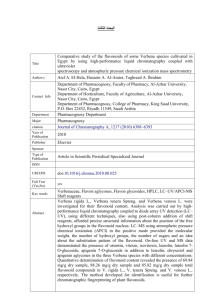File
advertisement

Prince Sattam bin Abdul-Aziz University College of pharmacy Department of Pharmacognosy Introduction to Herbal Botanical garden, Herbarium plant taxonomy and morphology lectures by: Osman A.O. Elmakki Osman Elmakki Pharmacognosy Department SAU 1 Botanical garden, herbarium and Taxonomy Osman Elmakki Pharmacognosy Department SAU 2 Part I General Definition of the botanical garden Osman Elmakki Pharmacognosy Department SAU 3 General Definition of the botanical garden • A place/ venue (controlled or semi controlled environment) to cultivate/ grow (cultural practices) different plant species for different purposes (public, conservation, recreation, global conservations, genetic conservation…etc) • Specific definition for herbal botanical garden • It’s a botanical garden made for academic and research purposes mainly in pharmacy by cultivation of medicinal, aromatic and poisonous plant species. Osman Elmakki Pharmacognosy Department SAU 4 A little about history People on all continents have used hundreds to thousands of indigenous plants for treatment of ailments since prehistoric times. In the written record, the study of herbs dates back over 5000 years to the Sumerians, who described well established medicinal uses for such established plants as laurel, caraway, and thyme. The first Chinese herbal book compiled possibly 2700 B.C. It lists 365 medicinal plants and their uses. Osman Elmakki Pharmacognosy Department SAU 5 Objectives of the BG why do we need a Herbal botanical gardens? • Objectives of the BG why do we need a Herbal botanical gardens? • Create a controlled environment to cultivate plants. • To provide samples of medicinal, aromatic and poisonous plants for academic and researches purposes. • To conserve the endanger medicinal plant species allover KSA. • To exchange experiences between different BG at national and international level. • To train students and researchers on different cultivation process. • To create a storage of the required plants for academic and research purposes Osman Elmakki Pharmacognosy Department SAU 6 Components of the HBG • • • • • • Green houses. High land area Low land area Irrigation system Storages. Main farms. Osman Elmakki Pharmacognosy Department SAU 7 Definition of the medicinal plants Any plant or part of the plants which provides healthpromoting characteristics and temporary relief. Is the plant or part of the plants that act to prevent and treat diseases and ailments or to promote health and healing. Osman Elmakki Pharmacognosy Department SAU 8 Definition of the aromatic & poisonous plant Aromatic plants: Is a plant or part of a plant that is characterized by a fragrant smell and usually by a warm, pungent taste as ginger, cinnamon. poisonous plants: A plant which contain specific chemical poisons, although they may not be identified. They are a different group from plants which cause illness if eaten in very large amounts or have physical qualities that cause illness Osman Elmakki Pharmacognosy Department SAU 9 How to grow medicinal plants • Selection of the medicinal plants (seeds or seedlings) that need to be grown. • Selection of the area for plantation. • Selection of the methods for plantation. • Selection of the proper irrigation system. • Selection of the time (season) • Prepare the medicinal plant for research and lab works. Osman Elmakki Pharmacognosy Department SAU 10 Good agricultural practices for medicinal plants Selection of medicinal plants Where applicable, the species or botanical variety selected for cultivation should be the same as that specified in the national pharmacopoeia or recommended by other authoritative national documents of the end-user's country. • Botanical identity The botanical identity – scientific name (genus, species, subspecies/variety, author, and family) – of each medicinal plant under cultivation should be verified and recorded. If available, the local and English common names should also be recorded. Osman Elmakki Pharmacognosy Department SAU 11 Cont. Good agricultural practices for medicinal plants • Specimens In the case of the first registration in a producer’s country of a medicinal plant or where reasonable doubt exists as to the identity of a botanical species, a voucher botanical • Seeds and other propagation materials Seeds and other propagation materials should be specified, and suppliers of seeds and other propagation materials should provide all necessary information relating to the identity Osman Elmakki Pharmacognosy Department SAU 12 Cont. Good agricultural practices for medicinal plants • Cultivation Cultivation of medicinal plants requires intensive care and management. The conditions and duration of cultivation required vary depending on the quality of medicinal plant materials required. If no scientific published or documented cultivation data are available, traditional methods of cultivation should be followed, where feasible. Otherwise a method should be developed through research. • Site selection Medicinal plant materials derived from the same species can show significant differences in quality when cultivated at different sites, owing to the influence of soil, climate and other factors. Osman Elmakki Pharmacognosy Department SAU 13 Part II Herbarium Osman Elmakki Pharmacognosy Department SAU 14 Herbarium is a collection of dried, pressed plants mounted on herbarium sheets bearing detailed data label and stored in a herbarium cabinet in a climate controlled room, preferable one that can be fumigated and one without windows that open. A herbarium can be thought of as a dried plant library, the pages of the books are the sheets of plants. Like a library, the “books” or dried plant specimens are arranged in systematic order by plant FAMILY Osman Elmakki Pharmacognosy Department SAU 15 Osman Elmakki Pharmacognosy Department SAU 16 The purpose of a herbarium? • A long term preservation material for taxonomic research • A store of reference material • Maintain nomenclatural standards • A comprehensive data-bank • Voucher specimen for any scientific publications Osman Elmakki Pharmacognosy Department SAU 17 Osman Elmakki Pharmacognosy Department SAU 18 How to collect plants • • • • Plants for herbarium Collection rules How to collect Collection consideration. Osman Elmakki Pharmacognosy Department SAU 19 1.0 Consideration for Collection of specimens • • • • • • • • • Do not decimate population if small or plant is rare. Try to sample most of variation present in population. At least one specimen should be fully excavated to display the root system. Spread plant to provide as many views as possible. Pay attention to laws/permit requirements No federal parks or reserves –need permission. No state parks County parks – ask No endangered species. Osman Elmakki Pharmacognosy Department SAU 20 2.0 Specimens label • • • • • • • Collectors’ name: Specimen number: Date collected: Location collected: Habitat description: Common name(s) of plant: Scientific name -Plant family: Characteristics = flower color, resin or latex if observed, height, bark, • fragrance, other unique characteristics Osman Elmakki Pharmacognosy Department SAU 21 3.0 dry specimen • the specimen after it is labeled it should be located in a dryer for some times until all parts of the plant is completely dry and no any moisture content appear. Osman Elmakki Pharmacognosy Department SAU 22 4.0 Mount specimen • Lay specimens out to observe maximum diagnostic characteristics • Root on bottom of paper, shoots towards the top • Leave space in the right hand corner for labels • Typically use acid-free paper, glue and ink • For class: any paper ok, Elmer’s glue ok Osman Elmakki Pharmacognosy Department SAU 23 Part III Taxonomy Osman Elmakki Pharmacognosy Department SAU 24 • Taxonomy is the science of systematically naming and organizing organisms into similar groups. • Plant taxonomy is an old science that uses the gross morphology (physical characteristics, i.e., flower form, leaf shape, fruit form, etc.) of plants to separate them into similar groups. • Quite often the characteristics that distinguish the plants become a part of their name. For example, Quercus alba is a white oak خشب البلوط, named because the underside of the leaf is white. • The development of more sophisticated microscopes and laboratory chemical analyses has made this new science possible. Osman Elmakki Pharmacognosy Department SAU 25 Carl Von Linne Osman Elmakki Pharmacognosy Department SAU 26 • Modern taxonomy originated in the mid-1700s when Swedishborn Carolus Linnaeus (also known as Carl Linnaeus or Carl von Linné) published his multi-volume Systema naturae, outlining his new and revolutionary method for classifying and, especially, naming living organisms. • Prior to Linnaeus, all described species were given long, complex names that provided much more information than was needed and were clumsy to use. Linnaeus took a different approach: he reduced every single described species to a twopart, Latinized name known as the “binomial” name. Thus, through the Linnaean system a species such as the dog rose changed from long, unwieldy names such as Rosa sylvestris inodora seu canina and Rosa sylvestra alba cum rubore, folio glabro to the shorter, easier to use Rosa canina. • This facilitated the naming of species that, with the massive influx of new specimens from newly explored regions of Africa, Asia, and America. Osman Elmakki Pharmacognosy Department SAU 27 Kingdoms • 1. 2. 3. 4. 5. all organisms on the planet are classified into 5 Kingdoms: Animalia (animals), Plantae (plants, some multicellular algae), Fungi (fungi), Monera (prokaryotic bacteria),(single cell organizm) and Protista (eukaryotic bacteria, most algae, etc.) Osman Elmakki Pharmacognosy Department SAU 28 Common Taxonomic Divisions • Taxonomic classification is the hierarchical organization of living beings into categories and subcategories that reveal their likenesses. • The scientific system of classification divides all living things into groups called taxa (singular, taxon). • Plants are in the Kingdom of Plantae. • and Animalia (animals). Osman Elmakki Pharmacognosy Department SAU 29 The plant kingdom is divided into two taxa broyophytes (including mosses (any of various kinds of small leafy plants which grow in clusters on different surfaces (ground, rocks, trees, etc.), )and liverworts) and vascular plants (plants with a vascular system of xylem and phloem). Vascular plants (sometimes called higher plants) are divided into two subgroups: seedless and seeded. Osman Elmakki Pharmacognosy Department SAU 30 Taxonomic classification Osman Elmakki Pharmacognosy Department SAU 31 • The seeded plants divides into two taxa • Gymnospermae (Gymnosperms)(plants whose seeds are exposed ) and • Angiospermae (Angiosperms)(plant whose seeds are contained in an ovary or fruit ). Produce seeds through flowering • Gymnosperms (meaning naked seed) do not produce flowers, but rather produce seeds on the end of modified bracts, such as pine cone))كوز الصنوبر. Osman Elmakki Pharmacognosy Department SAU 32 Angiospermae are devided into two taxa: Monocotyledon (monocote) A monocot has only one seed leaf Dicotyledon (dicote) A dicot has two cotyledons (dicot is short for 'dicotyledon', and 'di' means two). Osman Elmakki Pharmacognosy Department SAU 33 Monocots VS. Dicots Osman Elmakki Pharmacognosy Department SAU 34 Families Families of higher plants are separated from one another by characteristics inherent in their reproductive structures (flowers, fruit, and seed). Many family members share common characteristics in plant appearances, seed location and appearance, and growth habit. However, some families have a lot of diversity in appearance. Examples: Caprifoliaceae – Honeysuckle family, including Elders, Honeysuckle, Snowberry and Viburnum Fabaceae – Pea family, including Japanese Pagoda, Locust and Siberian Peashrubs Oleaceae – Olive family, including Ash, Forsythia, Lilac and Privet Rosaceae – Rose family, including Apples, Cotoneaster, Crabapples, Potentillas, Peach, Plum, Mountain Ash, and 250 common landscape plants Osman Elmakki Pharmacognosy Department SAU 35 Genus and Species • The taxonomic divisions beyond the family level are the genus and specific epithet(nickname) names, together called the species. Plants are named using a binomial system. • The genus name comes first and is similar to a person’s last name (like; Smith). • The specific epithet names follows as a more specific identifier. • It would be analogous to a person’s first name (like John).Genus Specific epithet Smith John • Catalpa speciosa Osman Elmakki Pharmacognosy Department SAU 36 Genera (plural of genus) are groupings whose members have more characteristics in common with each other than they do with other genera within the same family. Similarity of flowers and fruits is the most widely used feature, although roots, stems, buds, and leaves are also used. Common names of plants typically apply to genera. For example Acer )(الدردارis the genus of maples, Fraxinus is the ash, and Juniperus is the junipers(العرعر.) Osman Elmakki Pharmacognosy Department SAU 37 Plant parts Osman Elmakki Pharmacognosy Department SAU 38 Pronouncing scientific names • Genus and specific epithet names are universal in spelling (that is each plant has a single genus and specific epithet name, spelled the same, worldwide). • However, pronunciation of scientific names is not universal, and will vary based on the local language. For example, the tomato may be pronounced ‘toemay-toe’ or ‘toe-mah-toe’. • Based on the native language and local dialect of the user, scientific names may actually sound rather different in various countries. • Many Latin names have become ‘generic’ common names. For example: anemone, rhododendron, crocus, and viburnum. Osman Elmakki Pharmacognosy Department SAU 39 Latin names add meaning • • • • • • • • • • • • • Latin names often add meaning about the plant’s description, for example: o American = of America – Fraxinus americana (white ash) o Baccata = berry bearing – Taxus baccata (common yew) o Micro = little, small – Antennaria microphylla (littleleaf pussytoes) o Officinalis = medicinal – Rosemarius officinialis (rosemary) o Repens = creeping, crawling – Mahonia repens (creeping Oregon grape) o Undulata = wavy – Quercus undulata (wavyleaf oak) o Variegatus = variegated – Miscanthus sinensis ‘Variegatus’ (variegated Japanese silver grass) o Vulgaris = common -- Syringa vulgaris (common purple lilac) o Alba = white – Quercus alba (White oak) o Niger = black – Pinus nigra (Black pine) o Ruber = red – Acer rubrum (Red maple), Quercus rubra (Red oak) o Sanguineus = blood-red – Geranium sanguineum Osman Elmakki Pharmacognosy Department SAU 40 Medicinal plants name االسم االنجليزي األسم الالتيني الفصيلة Cayenne Pepper Capsicum annuum Solanaceae فلفل الشطة Coffee Coffea arabica Rubiaceae القهوة Tooth Brush tree Salvadora persica Salvadoraceae شجر األراك Roselle Hibiscus sabdariffa Malvaceae الكركدي Date palm Phoenix dactylifera palmae نخيل البلح Nigella Nigella sativa Ranunculaceae حبة البركة Osman Elmakki Pharmacognosy Department SAU 41 Osman Elmakki Pharmacognosy Department SAU 42 Common names • On the other hand, common names are often local in use and many times do not clearly identify the specific plant. For example, Liriodendron tulipfera is known as the Tulip Tree in the north and as Yellow Poplar in the south. Carpinus caroliniana goes by American Hornbeam, Blue Beech, Musclewood, Water Beech, and Ironwood • The European White Lily, (Nymphaea alba), has • 15 English common names • 44 French common names • 105 German common names • and 81 Dutch common names. Osman Elmakki Pharmacognosy Department SAU 43 Lecture II Part IV Morphology Osman Elmakki Pharmacognosy Department SAU 44 Morphology • It deals with the outer shape of the plant. • Morphology is very important for plants identification and classification. • Classification of flowering plats is based mainly on the Morphology of the flowers. Osman Elmakki Pharmacognosy Department SAU 45 Osman Elmakki Pharmacognosy Department SAU 46 The Leaves • Leaves originate directly from the nodes and may have stipules and auxiliary bud. • Each leave composed of : – Leaf baseقاعدة الورقة – Stipules برعم ابطي – Leaf stalk or petioleعنق الورقة – Leaf blade or lamina نصل الورقة Osman Elmakki Pharmacognosy Department SAU 47 Osman Elmakki Pharmacognosy Department SAU 48 Leaf arrangements •opposite - two leaves (a pair) attached per node, usually opposite each other. •alternate - one leaf attached per node, usually staggered (spiral) along stem. •whorled - three or more leaves attached per node, usually equally spaced around the node. Osman Elmakki Pharmacognosy Department SAU 49 Leaf attachment •Petiolate - the blade is attached to the stem by a petiole. •Sessile - the blade is attached directly to the stem without a petiole. Osman Elmakki Pharmacognosy Department SAU 50 Leaf margins Osman Elmakki Pharmacognosy Department SAU 51 Leaf shapes Osman Elmakki Pharmacognosy Department SAU 52 Leave can be: Simple leaves: Consists of single leaf blade (lamina). Compound leaves: Consists of separate leaflets each has separate lamina and secondary leaf stalk but never have stipules and auxillay buds. Osman Elmakki Pharmacognosy Department SAU 53 Leaf venation (arrangement of veins) •Pinnate venation - feather-like, net venation with lateral veins extending from a central midrib. •palmate venation - finger-like, net venation with several major veins diverging from the union of the petiole and the leaf blade. •parallel venation - principal veins parallel to the axis of the leaf. Osman Elmakki Pharmacognosy Department SAU 54 Leave Shapes Osman Elmakki Pharmacognosy Department SAU 55 Osman Elmakki Pharmacognosy Department SAU 56 Osman Elmakki Pharmacognosy Department SAU 57 Flower the seed-bearing part of a plant, consisting of reproductive organs (stamens and carpels) that are typically surrounded by a brightly coloured corolla (petals) and a green calyx (sepals). Osman Elmakki Pharmacognosy Department SAU 58 Osman Elmakki Pharmacognosy Department SAU 59 Parts of flower: Male Parts •Stamen ي في الزهرة َّ ال ّ العضو الذَّ َكر. سداة This is the male part of the flower. It is made up of the filament and anther, it is the pollen producing part of the plant. The number of stamen is usually the same as the number of petals. •Anther سداة المحتوي على اللقاح في النبات َّ المئْبَر وهو جزء ال ِ This is the part of the stamen that produces and contains pollen. It is usually on top of a long stalk that looks like a fine hair. •Filament الخيط This is the fine hair-like stalk that the anther sits on top of. Female Parts • Pistil عضو التأنيثcarpel This is the female part of the flower. It is made up of the stigma, style, and ovary. Each pistil is constructed of one to many rolled leaf like structures. •Stigma السمة One of the female parts of the flower. It is the sticky bulb that you see in the center of the flowers, it is the part of the pistil of a flower which receives the pollen grains and on which they germinate. •Style حامل السمة Another female part of the flower. This is the long stalk that the stigma sits on top of. •Ovaryالمبيض The part of the plant, usually at the bottom of the flower, that has the seeds inside and turns into the fruit that we eat. The ovary contains ovules. •Ovule بيضة غير ملقحة The part of the ovary that becomes the seeds. Osman Elmakki Pharmacognosy 60 Department SAU Osman Elmakki Pharmacognosy Department SAU 61 Other Important Parts of a Flower •Petalالبتلة The colorful, often bright part of the flower. They attract pollinators and are usually the reason why we buy and enjoy flowers. •Sepalالكأس The parts that look like little green leaves that cover the outside of a flower bud to protect the flower before it opens. Osman Elmakki Pharmacognosy Department SAU 62 Flower Types •Imperfect Flower A flower that has either all male parts or all female parts, but not both in the same flower. Examples: cucumbers, pumpkin, and melons. •Perfect Flower A flower that has both the male parts and female parts in the same flower. Examples: roses, lilies, and dandelion. Osman Elmakki Pharmacognosy Department SAU 63 Perfect & imperfect flower Osman Elmakki Pharmacognosy Department SAU 64 Floral Formula A floral formula is a system of representing the structure of a flower using specific letters, numbers, and symbols. A floral formula is a written shorthand used to represent the structure of a flower using the standard set of symbols shown at the right. The four major floral parts are always shown in the same order; sepals (CA) petals (CO) stamens (A) and carpels (G). The number of each part in the flower is indicated with a superscript number after the letters. Osman Elmakki Pharmacognosy Department SAU 65 COMPONENTS AND SYMBOLS OF FLORAL FORMULA CaX = Calyx (sepal whorl) X = number of sepals (e.g. Ca5 = 5 sepals) CoX = Corolla (petal whorl) X = number of petals (e.g., Co3(x) = petals some multiple of three ) Z = add if Zygomorphic (e.g., CoZ6 = zygomorphic (Bilaterally symmetrical) with 6 petals) AX = Androecium (The stamens of a flower considered as a group) (whorl of stamens) X = number of stamens (e.g., A∞ = many stamens) GX = Gynoecium (ovary bearing carpels) X = number of carpels: if one, termed 'monocarpous', if two or more and free or distinct, termed 'apocarpous', if two or more and fused, termed 'syncarpous' or connate. (e.g., G1 = monocarpous) OTHERS: CaCo= perianth; if sepals and petals are alike termed 'tepals'; = adnate, or fusion of two different floral Osman Elmakki Pharmacognosy Department SAU 66 Floral formula A floral formula is a way to represent the structure of a flower using specific letters, numbers, and symbols. Typically, a general formula will be used to represent the flower structure of a plant family rather than a particular species. The following representations are used: Ca = calyx (سبلة الزهرةsepal whorl; e. g. Ca5 = 5 sepals) Co = corolla ( تويج الزهرةpetal whorl; e. g., Co3(x) = petals some multiple of three ) Z = add if zygomorphic (e. g., CoZ6 = zygomorphic with 6 petals) A = androecium (whorl of stamens; e. g., A∞ = many stamens) G = gynoecium (carpel or carpels; e. g., G1 = monocarpous) x: to represent a "variable number“ ∞: to represent "many" A floral formula would appear something like this: Ca5Co5A10 - ∞G1 Osman Elmakki Pharmacognosy Department SAU 67 The floral formulas •+ , + +• ,K (5), C 5, A 5+5, G 5, superior • __ • , , K (5), C 5, A ∞, G 2 , ,K pappus, C 5, A 5, G 2 • + Osman Elmakki Pharmacognosy Department SAU 68







